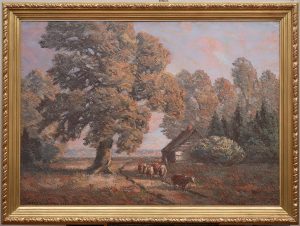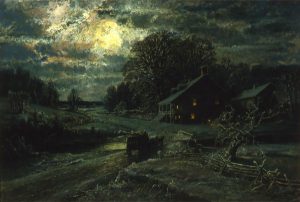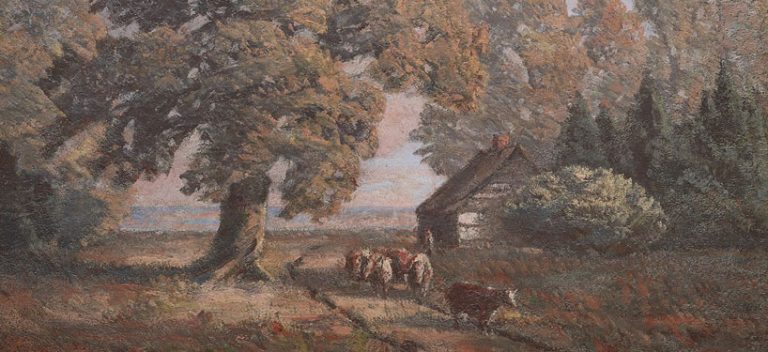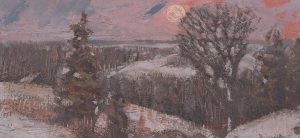
34” by 49” Donated from the Scotia Bank collection on June 19, 2018
Historic paintings often provide a unique perspective of the past. Unlike photographs, they are not perfect reproductions of a given vantage, but this imperfection doesn’t mean that such paintings cannot function as a record of the past. In fact, when a painting depicts a particular landscape or structure that no longer exists, we experience the artist’s interpretation, or their memory, which presents us with a fascinating look not only at what once was but also how that artist remembered it.
Homer Watson painted The Cabin in the Lane, pictured above, later in his life. The scene portrays his hometown of Doon (now Kitchener) and features the thick brushstrokes and grand depictions of nature that are characteristic to his later works. Visible is an old log cabin, which was part of his grandfather’s bush farm. Watson regularly voiced the role of nostalgia and memory in his artwork, especially when it came to depicting particular places. When he painted this piece, the log cabin depicted no longer existed. Another Watson painting, On the Old Stage Road, November Night, similarly depicts an inn that was not standing in 1881 when he painted this work.

The inn pictured here, the Bush Inn, was built between 1853 and 1854 and was frequently used by those travelling by stage coach. The inn burned down in 1867 and was not rebuilt, but it was remembered by Watson. He recalled that: “the old inn had a charm for me,” and so he memorialized it in this 1881 painting.
Paintings such as these are even more valuable to researchers when working with historical periods that pre-date photography. Though Watson painted both scenes from memory, the paintings provide evidence of these buildings’ existence and a visual representation of the types of buildings that once existed in Doon, in the absence of photographs.
The original buyer of The Cabin in the Lane piece, W.H. Gregory, manager of the British Mortgage and Trust Corporation, inquired with Watson about the inspiration for the painting. Homer responded as follows:
“The subject is one carried along in memory of a pioneer log cabin renovated a bit, and standing up bravely in an old clearing as it appeared in bygone days in an old bush farm belonging to my grandfather. The cabin has disappeared like all of the old things. This is why I try to recall them.”
The memory of this cabin was significant to Homer Watson and tells us much about his love for nature-filled rural landscapes. The winding road with a cabin to its side, surrounded by tall trees, is a common motif throughout his artwork.
How Watson remembered both his grandfather’s cabin and the Bush Inn certainly coloured his depiction of them, and such interpretation adds new, personal depth to the scenes he chose to depict. As we look at these paintings now, more than a century down the line, we can learn and understand as much about the artist as we do the landscapes he painted, giving us a portrait of the person as well as the place.

















